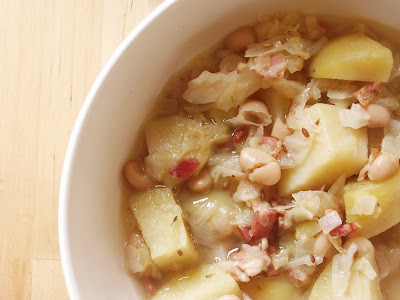Fermented foods scare me. I'm totally happy to eat them when prepared by other people, but I'm terrified of making them myself. What if I get it wrong? What if they go off? What if we all get botulism and end up in hospital and, you know, die?
Sure they're traditional, and 'everyone' used to make them – but my mother didn't, and nor did either of my grandmothers. In fact, I don't know anyone who has ever fermented foods, outside the usual group house refrigerator disasters. So I have no knack, no sense of how to do it, and no confidence.
But I eat mountains of living foods, particularly sauerkraut, and they're not cheap: my favourite sauerkraut costs $13.95 a jar. Worse, it comes from Byron Bay in a refrigerated truck – hardly local, sustainable eating for this Melburnian.
So the combination of my cheapness and my desire to eat locally led me to look up recipes for sauerkraut. I concluded that it isn't actually difficult – no expertise required - so I gave it a go. It took ten minutes, then five days of resting. At the end of that time, I had a slightly funky kitchen and a big jar of perfectly fermented local sauerkraut, made by me! What's not to like?
Sauerkraut is delicious with grilled chicken, sausages, or tossed through a quinoa salad. It's also fantastically healthy, but talking about nutrition bores me. If you want to learn about how eating sauerkraut tends your sacred inner garden (sigh), click here!
Sauerkraut with Caraway and Dill - 1 green cabbage Slice the cabbage as thinly as possible. It's easiest to shove it through the shredding attachment of a food processor; otherwise, use a big sharp knife. Chop the dill. Combine the cabbage with the dill and caraway seeds. Gently rub the salt into the mixture. Discover any open cuts, and suck your finger. Liquid will begin to seep out of the cabbage. Firmly pack everything into a large glass or ceramic jar. Place a weight on the cabbage to hold it down. You can use a small plate with a clean stone on it, a smaller glass jar full of water, rolled cabbage leaves etc. Top up with brine, until the cabbage and the weight are submerged. Leave in a cool place for five to seven days – check it every day and watch it change. It's fascinating! If any mould appears, skim it off with a spoon. When the cabbage looks and smells right – kind of sour, but not gross – refrigerate. The longer you leave it, the softer its texture and the stronger and sourer its flavour. I prefer mine slightly crunchy and not too sour, which takes about five days of fermentation. It will keep for at least six weeks in the fridge. To use: I am reluctant to use less than the standard ratio of salt to cabbage as the salt is the preservative; however, I find it a bit salty to eat straight from the jar. Therefore, before serving the sauerkraut I place it in a colander and give it a rinse, then leave it to drain while I prepare the rest of dinner. (Local: cabbage. Garden: dill. Imported organic: caraway seeds. Northern Victoria: salt.) |




























